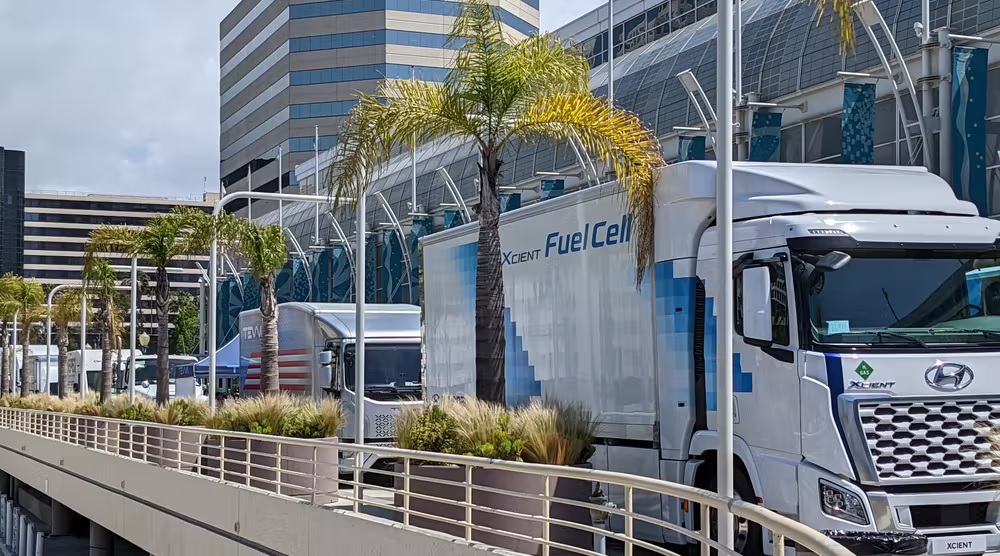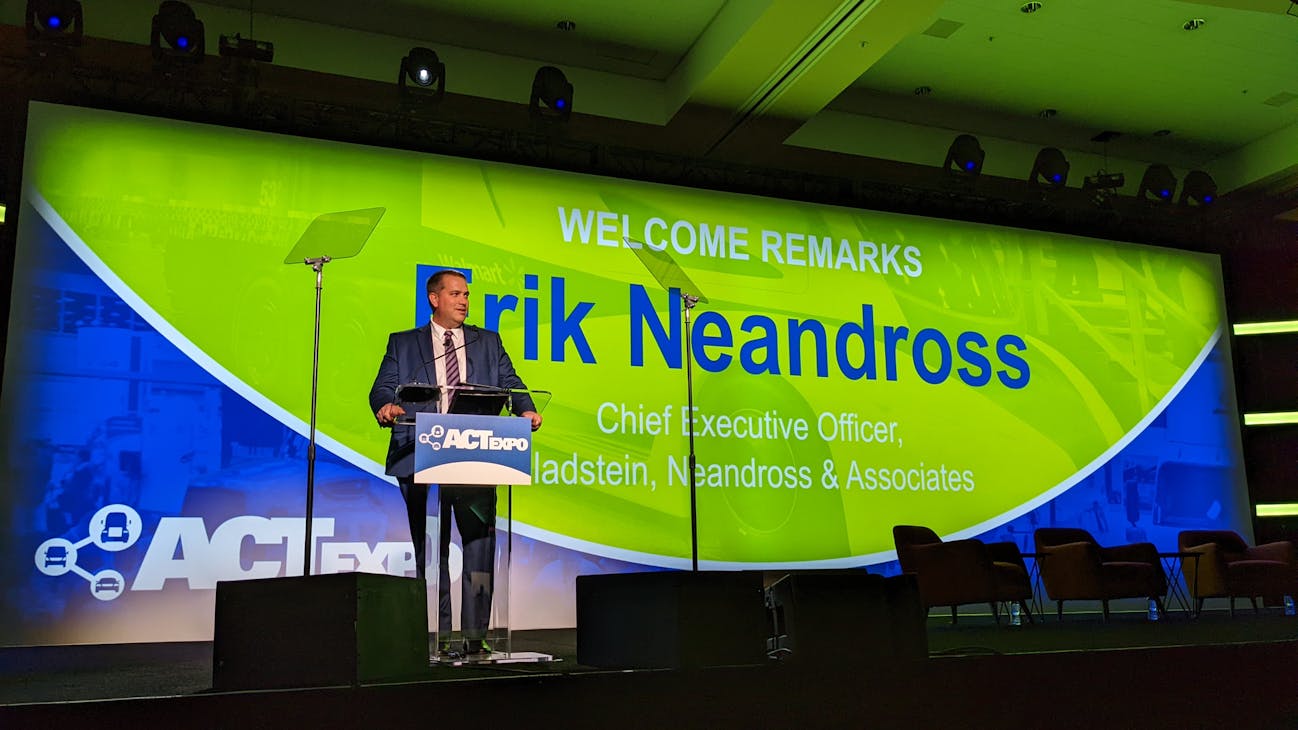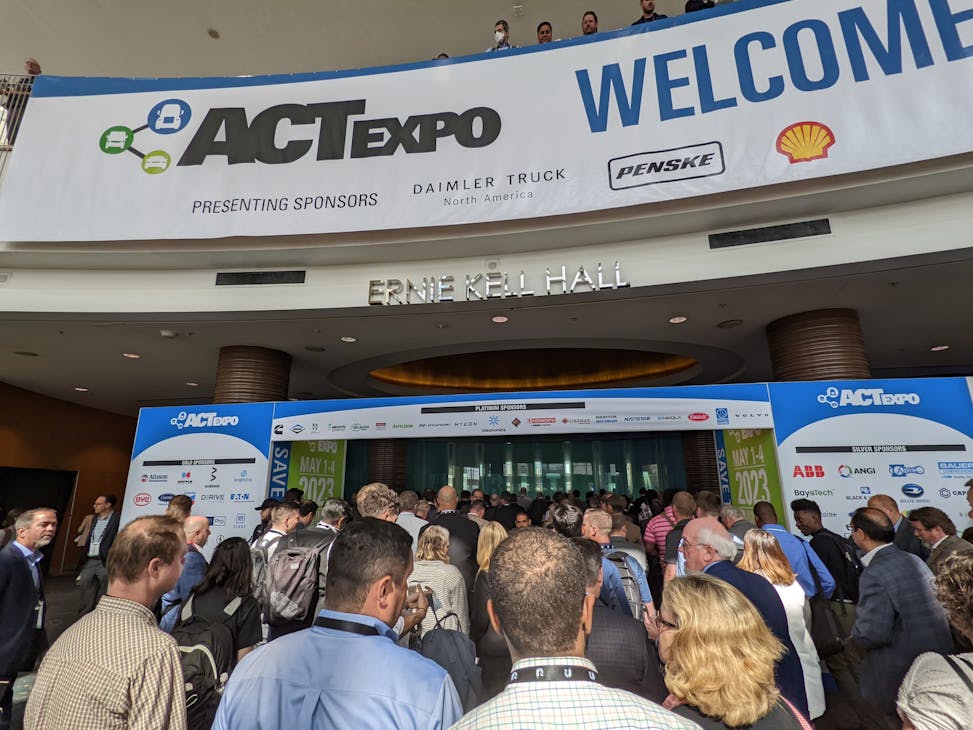LONG BEACH, California—Spurred on by regulations and corporate sustainability movements over the past year, more fleets are making a transformational shift from traditional fuel sources as more public and private money is flooding into the zero-emission movement.
From the manufacturers to the end-users, decarbonization commitments are all the rage in 2022. On top of this are various local, federal, and international regulatory pushes for the transportation industry to find sustainability solutions. “There’s massive investment in this sort of clean-tech space—that’s where all the money is now,” Erik Neandross, CEO of Gladstein, Neandross & Associates, told FleetOwner.
The clean-technology consulting firm released its third-annual State of Sustainable Fleets report at the start of the GNA-organized Advanced Clean Transportation Expo here, which drew more than 7,500 to Southern California. That’s more than twice as many transportation industry professionals who gathered at the Long Beach Convention Center for last summer’s ACT Expo. The future fleet expo and conference is getting so big it will move to a larger facility in Anaheim in 2023.
Historically, GNA has focused on natural gas, helping large private fleets find an alternate solution to diesel. But for Neandross, it’s not about which new fuel source wins out, it’s about the destination.
“We’re not really focused on the science, R&D, and technology development for technology development’s sake,” he said before ACT Expo opened on May 9. “We actually want to help people to run their businesses on something cleaner, something better, something cheaper. It’s really critical that we have economic sustainability right up there with environmental sustainability.”
Zero-emission ‘perfect storm’
Neandross said the transforming fleet market and regulations created an ideal environment for the zero-emission movement even before oil prices shot up this year and diesel set price records. “The $5.50 diesel is sort of like cloud seeding right on top of this perfect storm,” he added.
Diesel prices in 2021 reached their highest levels since 2014 (up 19% in a year), according to the report. Since then, inflation and Russia’s invasion of Ukraine have driven diesel prices to historic record highs.
Until recently it was large companies such as Waste Management and PepsiCo on the private fleet side and UPS Inc. on the for-hire side that were able to convert thousands of their vehicles to alternate energies. Those companies are three of the largest fleets in the U.S., according to the 2022 FleetOwner 500: For-Hire ranking and the private fleet rankings.
“It wasn’t really for the masses,” Neandross said. “There were a lot of people that would sort of dip their toe in the water.” But for smaller fleets, it wasn’t necessarily safe to try out other fuel sources because their competitors likely ran on diesel. “Just being different was inherently risky,” he added.
Since COVID-19, there’s been “a real change in the dialogue around carbon,” he said. (Neandross doesn’t believe the pandemic caused this change—it just happened that industry consensus and technology moved forward during that time.) “You now see these big corporations saying they have to be a part of the solution. We think the report does a good job of laying out this whole ESG world. This is new stuff. There are very few companies that really understand it and really do a good job with it.”
Authors of the sustainable fleets report surveyed about 250 U.S.-based fleets that have used clean fuels and vehicles—those running on propane, compressed natural gas (CNG), battery-electric, or fuel-cell electric. Nearly 85% of the fleets surveyed reported their use of clean-vehicle technologies will grow over the next five years.
For companies looking to make significant climate commitments that mirror the Paris Climate Accords, Neandross said that means cutting emissions by 80% to 90%. “You can’t do that with diesel. You can’t do that by just being a SmartWay partner,” Neandross noted. “Those days are behind us at this point. You have to do something much more dramatic.”
Most companies aren’t yet willing to take those dramatic steps. “But I think it will continue to accelerate and grow,” he predicted.
‘The cost of doing business’ in 2022
As larger companies and fleets move further down the lower-emission pathway, Neandross said he believes others will follow. “There’s a recognition—because the leaders are doing it—this is just the cost of doing business,” he explained. “We can’t be a laggard and just thumb our nose at this climate thing.”
While large fleets such as UPS and PepsiCo have found success with alternate fuels, battery-electric power has not been among them. “The challenge right now we see with electrification, in particular, is it’s pretty hard to make the business case because the stuff is expensive,” Neandross explained. “It’s still very new, and we’re just not there yet.”
“Some people—the ZE advocates, people like CARB—they want to make you believe that every application can be filled with a battery-electric truck today,” he said. “And that it makes perfect financial sense. That these things pay for themselves because they have low-cost maintenance. That’s just hogwash.”
Fleets are grappling with regulations, such as California’s push to phase out diesel by 2045 and federal clean truck rules. They’re also facing tough decisions about future technologies. “If you’re operating a fleet today, it is a battle,” Drew Cullen, SVP of fuels and facilities services at Penske Transportation Services, one of the report sponsors, said during a mainstage session on ACT Expo’s opening day.
“It’s a battle, whether it’s drivers, whether it’s high energy costs, whether it’s equipment,” Cullen continued. “So it’s really hard to start thinking about a rule that is going to be coming into play in a couple of years. You’ve got so much going on right now just to keep your business running and satisfy your customers.”
With BEV equipment still costly and substantial charging infrastructure lacking across the nation, some larger fleets are finding success with compressed natural gas. “If you’re a fleet like a UPS and you’re burning 20,000 gallons of diesel per year per truck—and diesel is up to $5.50, that’s real money,” Neandross explained.
The sustainability report found that CNG had a clear cost advantage—and more stable prices—than diesel. In 2021, CNG prices nationwide rose 3% at public fueling stations; diesel went up 19%. Fleets that embraced CNG saw clear economic benefits, according to the study: 79% reported cost savings as a primary advantage; some of them reported finding return on investment (ROI) within three years.
Government emission regulations and ZE grants
A key to increased adoption of near- and zero-emission transportation across the public and private sectors, including accompanying fueling and charging infrastructure, is record-setting government funding and legislative support at both the state and federal levels, according to report findings.
“The nation of California”—as Neandross referred to the Golden State—continues to lead in vehicle and infrastructure funding as well as progressive zero-emission regulations. Five other states—Oregon, Washington, New Jersey, New York, and Massachusetts—are following suit with their own similar regulations based on California’s that requires OEMs to sell increasing numbers of zero-emission trucks.
The report found public incentives for clean fuel and vehicles will increase to about $20 billion annually through more than 230 programs over the next few years. That’s almost seven times the $3 billion available in recent years. Much of the funding growth comes with the $1.2 trillion Infrastructure Investment and Jobs Act.
Other findings in the 2022 State of Sustainable Fleets report
Here are some of the other key report findings on how fleets are using BEVs, CNG, hydrogen, and other fuel types. The State of Sustainable Fleets report was sponsored by Daimler Truck North America, Penske Transportation Solutions, and Shell Oil Co. Cummins Inc. is a supply chain sponsor of the report.
- Battery-electric vehicle demand is increasing despite supply chain delays, and BEVs cost more than traditional vehicles.
- Scheduled medium- and heavy-duty BEV deployments are expected to grow from dozens at the start of the decade to hundreds this year and next.
- Vehicle manufacturers are becoming more involved in the battery-electric ecosystem by providing value-add services to fleets learning to operate in this new and unfamiliar space.
- Certain sectors, such as school buses, are already seeing early scale. A total of 1,800 battery-electric school buses have been ordered or deployed by more than 350 school fleets in the U.S. to date.
- A few hundred more grant-funded Class 8 battery-electric vehicle orders from major manufacturers were placed in 2021 and early 2022.
- Orders still far outpace vehicle deliveries, and battery prices remain stubbornly high.
- CNG fuel is priced right.
- Among surveyed fleets, 73% report that fuel cost savings are a primary advantage for deploying natural gas units.
- Transit buses, straight trucks (including refuse), and Class 8 tractors are the dominant sectors driving CNG vehicle sales.
- Natural gas vehicle registrations rose 3% from 2020 to 2021.
- Most fleets that have piloted or purchased CNG trucks in the past two years reported equal or better performance on emissions (96% of fleets), noise (87%), fuel supply (67%), and total cost of ownership (57%) as compared to diesel.
- Renewable diesel growth is very strong.
- Production capacity for renewable diesel increased from 600 million to 800 million gallons per year between late 2020 and mid-2021.
- By 2025, U.S. production capacity of renewable diesel is forecasted to exceed five billion gallons annually, a six-fold increase from 2021.
- Renewable diesel adoption is highest among government fleets: Nearly half of state, county, or municipal fleets reported usage of the fuel.
- Propane—also known as autogas—fuel is affordable with a sub-$2 per gallon cost.
- Among the more mature clean vehicle platforms highlighted in the report, four states—California, Florida, Michigan, and Texas—accounted for roughly 30% of the national demand for propane vehicle fuel.
- Propane-powered trucks are most often used by state, county, and municipal fleets (43% of fleet types in the survey).
- Propane usage also is more common among fleets with 101-500 vehicles—35% of propane-using fleets were this size.
- Hydrogen vehicles are on the horizon with larger grant-funded demonstrations beginning recently.
- The report found that total hydrogen medium- and heavy-duty truck purchases in the U.S. totaled nearly 150 orders in 2021.
- There were no public hydrogen stations outside of California in 2021.
- Fifty-seven more public hydrogen filling stations, primarily for light-duty vehicles, are planned in California, Ohio, New York, Rhode Island, Connecticut, and Massachusetts.
- Dozens of grant-funded fuel-cell electric tractors are on order by leading fleets.
The report is free to download at stateofsustainablefleets.com.
By Josh Fisher
Source https://www.fleetowner.com/







